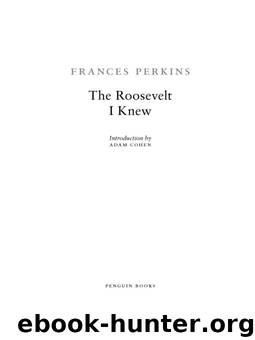The Roosevelt I Knew by Frances Perkins

Author:Frances Perkins
Language: eng
Format: mobi, azw3, epub
Publisher: Penguin Publishing Group
Published: 2011-05-20T04:30:00+00:00
18.
LABOR AND THE CODES
The NRA was a seed bed out of which many other activities and experiments grew. It was not only an administrative enterprise, but also a forum in which employers and workers, the government and the public, met and debated ideas and issues.
I doubt that it had crossed the President’s mind that NRA would raise problems of industrial relationships. The depression had been marked by few strikes or industrial disputes. Workmen had been frightened, and unions enfeebled by loss of jobs and of members. In 1933 American Federation of Labor membership had fallen to about two million. That embraced all the craft and industrial unions of the country, with the exception of the Railroad Brotherhoods, which had a membership of about 270,000, and the Amalgamated Clothing Workers, which had been separated from the AF of L for many years and had a small but effective membership.
The NRA Labor Advisory Board was not in a strong position when it came to pressing the point of view of the workers in the consideration of codes. There was relatively little organization in the large manufacturing and distributive industries where codes were needed most and were being drawn up first. The Labor Committee, when consulted about a code, was obliged to rely largely upon the Department of Labor for information about working conditions in an industry, an industry’s earnings, the cost of living in the area, and so on. In many industries the Labor Department was the only spokesman for the workers’ needs.
There were eight or ten employees in the Department in this period who did little but serve on code committees, recommending wages, hours, and other working conditions based on Departmental and Bureau research and judgment. The advice of the Labor Advisory Board was good and, on the whole, sound, because of the experience of its members. However, one could not escape the fact that representation of working people through their own organizations was pathetically limited.
Consider the case of the steel code, one of the first proposed under the NRA. The way it was handled was typical of the problems of the day.
The depression had dried up the demand for steel, and it is doubtful whether any steel company was making money. Some were losing badly. United States Steel, for example, was in a difficult situation. It had relied largely on structural and heavy steel and had not been driven to put in new rolling mills and blast furnaces or equip itself to produce the small items which, in the depth of the depression, had almost the only market. United States Steel was pressing for a steel code, and Bethlehem and the other large companies were also willing, though doubtful on some points.
It is possible, as has often been charged, that the great industrialists of the steel corporations were mostly concerned with reaching agreements, with the blessing of the NRA, which would be legal under the anti-trust act—agreements on pricing, marketing practices, and other matters. Certainly, however, those who voted for
Download
The Roosevelt I Knew by Frances Perkins.azw3
The Roosevelt I Knew by Frances Perkins.epub
This site does not store any files on its server. We only index and link to content provided by other sites. Please contact the content providers to delete copyright contents if any and email us, we'll remove relevant links or contents immediately.
| American Revolution | Civil War |
| US Presidents |
Fanny Burney by Claire Harman(26257)
Empire of the Sikhs by Patwant Singh(22775)
Out of India by Michael Foss(16695)
Leonardo da Vinci by Walter Isaacson(12817)
Small Great Things by Jodi Picoult(6694)
The Six Wives Of Henry VIII (WOMEN IN HISTORY) by Fraser Antonia(5244)
The Wind in My Hair by Masih Alinejad(4852)
The Crown by Robert Lacey(4579)
The Lonely City by Olivia Laing(4577)
A Higher Loyalty: Truth, Lies, and Leadership by James Comey(4566)
The Iron Duke by The Iron Duke(4127)
Millionaire: The Philanderer, Gambler, and Duelist Who Invented Modern Finance by Janet Gleeson(4117)
Papillon (English) by Henri Charrière(3924)
Sticky Fingers by Joe Hagan(3916)
Joan of Arc by Mary Gordon(3797)
Alive: The Story of the Andes Survivors by Piers Paul Read(3743)
Stalin by Stephen Kotkin(3731)
Aleister Crowley: The Biography by Tobias Churton(3435)
Ants Among Elephants by Sujatha Gidla(3282)
